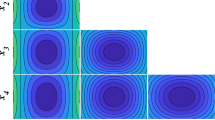Abstract
The conceptual design process has not benefited from conventional computer-aided design (CAD) technology to the same degree as embodiment design because the creative activities associated with developing and communicating alternative solutions, with minimal detail, is far less formulaic in its implementation. Any CAD system that seeks to support and enhance conceptual design must, therefore, enable natural and haptic modes of human–computer interaction. A computational framework for economically representing deformable solid objects for conceptual design is described in this paper. The physics-based deformation model consists of a set of point masses, connected by a series of springs and dampers, which undergo movement through the influence of external and internal forces. The location of each mass point corresponds to a node on a 3D mesh defined by a volumetric self-organizing feature map (VSOFM). A reference mesh is first created by fitting the exterior nodes of the VSOFM to sampled data from the surface of a primitive shape, such as a cube, and then redistributing the interior nodes to reflect evenly spaced hexahedral elements. Material properties are introduced to the mesh by assigning a mass value to individual nodes and spring coefficients to the nodal connections. Several illustrations involving the redesign of an ergonomic writing pen is used to demonstrate how the proposed virtual reality-based modeling system will permit the industrial designer to interactively change the shape and function of a design concept.
Similar content being viewed by others
References
Ashby F.M., Jones R.H.D. (2005). Engineering materials 1: An introduction to properties, applications and design. Boston, Elsevier Butterworth-Heinemann
Basdogan, C., Ho, C., Srinivasan, M. A., Small, S., & Dawson, S. (1998). Force interactions in laparoscopic simulations: Haptic rendering of soft tissues. Medicine Meets Virtual Reality (MMVR’6) Conference (pp. 385–391).
Bridson, R., Marino, S., & Fedkiw, R. (2003). Simulation of clothing with folds and wrinkles. ACM Siggraph/Eurographics Symposium on Computer Animation (pp. 28–36).
Choi, K. S. (2004). Interactive deformable simulation of soft tissues for virtual surgery applications. Ph.D. Thesis in Computer Science and Engineering, The Chinese University of Hong Kong.
Courant R., Friedrichs K., Lewy H. (1967). On the partial difference equations of mathematical physics. IBM Journal of Research and Development 11(2): 215–234
Dachille F., Qin H., Kaufman A. (2001). A novel haptics-based interface and sculpting system for physics-based geometric design. Journal of Computer-Aided Design 33, 403–420
Dani T.H., Gadh R. (1997). Creation of concept shape designs via a virtual reality interface. Journal of Computer-Aided Design 29, 555–563
Haykin S. (1999). Neural networks: A comprehensive foundation. New York, Macmillian
Holm, D. D., Marsden, J. E., & Ratiu, T. S. (1998). The Euler- Poincare equations in geophysical fluid dynamics. Proceedings of the Mathematics of Atmosphere and Ocean Dynamics (pp. 1–42).
Hua, J., & Qin, H. (2001). Haptic sculpting of volumetric implicit functions. Proceeding of 9th Pacific Conference on Computer Graphics and Applications (pp. 254–264).
Knopf, G. K., & Igwe, P. C. (2004). Sculpting free-form surfaces using interactive CAD. Flexible Automation and Intelligent Manufacturing (pp. 146–153).
Knopf, G. K., & Sangole, A. (2002a) Registration of closed free-form surfaces using deformable map. In C. H. Dagli, et al., (Eds.), Intelligent Engineering Systems Through Artificial Neural Networks: ASME Press, 12, 561–566.
Knopf, G. K, & Sangole, A. (2002b). Intelligent systems for interactive design and visualization. IEEE Conference of Industrial Electronics Society (pp. 2995–3001).
Knopf G.K., Sangole A. (2004). Interpolating scattered data using 2D self-organizing feature maps. Graphical Models 66, 50–69
Knopf, G. K., Sangole, A., & Igwe, P. (2003). Parameterization of scattered surface points using a SOFM. In C. H. Dagli, et al., (Eds.), Intelligent engineering systems through artificial neural networks (Vol. 13, pp. 33–38). ASME Press.
Kohonen T. (1997). Self organizing feature map. New York, Springer
Meyer M., Debunne G., Desbrun M., Barr A.H. (2000). Interactive animation of cloth-like objects for virtual reality. The Journal of Visualization and Computer Animation 12(1): 1–12
Noh, J., & Neumann, U. (1998). A survey of facial modeling and animation techniques. Technical Report, Integrated Media Systems Center, University of Southern California (pp. 1–26).
Park, H. (2003). An internet-based collaborative engineering system. Web Engineering: International Conference (ICWE2003) (pp. 451–454).
Provot, X. (1995). Deformation constraints in a mass-spring model to describe rigid cloth behavior. Proceedings Graphics Interface ’95 (pp. 147–154).
Sener, B., Wormald, P., & Campbell, R. I. (2002). Evaluating a haptic modeling system with industrial designers. In Proceedings of EuroHaptics (pp. 165–169).
Tam, K., Lau, R. W. H., & Ngo, C. (2004). Deformable object matching by topological geometric similarity. In Proceedings of the Computer Graphics International (pp. 335–342).
Terzopoulos, D., Platt, J., Barr, A., & Fleischer, A. (1987). Elastically deformable models. Siggraph Proceedings on Computer Graphics (Vol. 21, no. 4, pp. 205–214).
Yang Z., Lian L., Chen Y. (2005). Haptic evaluation of multi- material part design. Journal of Computer Aided Design 37, 727–736
Ye J., Campbell R.I. (2006). Supporting conceptual design with multiple VR based interfaces. Journal of Virtual and Physical Prototyping 1, 171–181
Author information
Authors and Affiliations
Corresponding author
Rights and permissions
About this article
Cite this article
Igwe, P.C., Knopf, G.K. & Canas, R. Developing alternative design concepts in VR environments using volumetric self-organizing feature maps. J Intell Manuf 19, 661–675 (2008). https://doi.org/10.1007/s10845-008-0118-0
Accepted:
Published:
Issue Date:
DOI: https://doi.org/10.1007/s10845-008-0118-0




